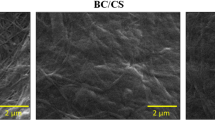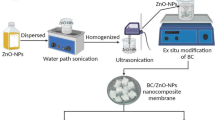Abstract
Recent research was conducted to evaluate the healing efficiency of bacterial cellulose (BC) as a wound dressing in different pHs and its possibility of being a smart wound dressing that can indicate pHs. BC was produced by environmentally isolated bacterial strains. After washing the best achieved BC, it was floated in normal saline with different pHs with phenol red used as a pH indicator. Finally the wound healing effects of the acidic, neutral and alkaline BC membranes were evaluated in rat cutaneous wounds. Results showed that one of the isolates which its partial 16srRNA genome had 95% similarity with Gluconacetobacter intermedius, had the thickest layer. The microscopic and macroscopic evaluations showed that the acidic BC had the best healing activity. Although the color of the films remained unchanged during the experiments because they were transparent and thin, these changes could not be easily seen. This suggests the use of thicker films such as the ones which are cross linked with some materials (e.g., sterile gauze). In conclusion the pH can affect the healing ability of natural BC and acidic pH had the best wound healing efficiency. In future it is better to use the acidic BC instead of natural one for different wound healing purposes.





Similar content being viewed by others
References
Schneider LA, et al. Influence of pH on wound-healing: a new perspective for wound-therapy? Arch Dermatol Res. 2007;298:413–20.
Schreml S, et al. The impact of the pH value on skin integrity and cutaneous wound healing. J Eur Acad Dermatol Venereol. 2010;24:373–8.
Yahyaei B, et al. Production, assessment, and impregnation of hyaluronic acid with silver nanoparticles that were produced by Streptococcus pyogenes for tissue engineering applications. Appl Biol Chem. 2016;59:227–37.
Pourali P, et al. Impregnation of the bacterial cellulose membrane with biologically produced silver nanoparticles. Curr Microbiol. 2014;69:785–93.
Pourali P, et al. PCR screening of the Wolbachia in some arthropods and nematodes in Khuzestan province. Iran J Vet Res. 2009;10:216–22.
Pourali P, Razavian Zadeh N, Yahyaei B. Silver nanoparticles production by two soil isolated bacteria, Bacillus thuringiensis and Enterobacter cloacae, and assessment of their cytotoxicity and wound healing effect in rats. Wound Repair Regen. 2016;24:860–9.
Pourali P, Yahyaei B. Biological production of silver nanoparticles by soil isolated bacteria and preliminary study of their cytotoxicity and cutaneous wound healing efficiency in rat. J Trace Elem Med Biol. 2016;34:22–31.
Nagoba BS, et al. Acidic environment and wound healing: a review. Wounds. 2015;27:5–11.
Yahyaei B, et al. Production of electrospun polyvinyl alcohol/microbial synthesized silver nanoparticles scaffold for the treatment of fungating wounds. Appl Nanosci. 2018:1–10. https://doi.org/10.1007/s13204-018-0711-2.
Vermeulen H, et al. Topical silver for treating infected wounds. Cochrane Libr. 2007;1:CD005486.
Percival SL, et al. The antimicrobial efficacy of silver on antibiotic‐resistant bacteria isolated from burn wounds. Int Wound J. 2012;9:488–93.
Nagoba B, et al. Microbiological, histopathological and clinical changes in chronic infected wounds after citric acid treatment. J Med Microbiol. 2008;57:681–2.
Queen D, et al. A dressing history. Int Wound J. 2004;1:59–77.
Ross P, Mayer R, Benziman M. Cellulose biosynthesis and function in bacteria. Microbiol Rev. 1991;55:35–58.
Esa F, Tasirin SM, Rahman NA. Overview of bacterial cellulose production and application. Agric Agric Sci Procedia. 2014;2:113–9.
Kucińska-Lipka J, Gubanska I, Janik H. Bacterial cellulose in the field of wound healing and regenerative medicine of skin: recent trends and future prospectives. Polym Bull. 2015;72:2399–419.
Ji K, et al. Bacterial cellulose synthesis mechanism of facultative anaerobe Enterobacter sp. FY-07. Sci Rep. 2016;6:21863.
Wanna D, et al. Bacterial cellulose–kaolin nanocomposites for application as biomedical wound healing materials. Adv Nat Sci Nanosci Nanotechnol. 2013;4:045002.
Wu J, et al. Silver nanoparticle/bacterial cellulose gel membranes for antibacterial wound dressing: investigation in vitro and in vivo. Biomed Mater. 2014;9:035005.
Pourali P, et al. Biosynthesis of gold nanoparticles by two bacterial and fungal strains, Bacillus cereus and Fusarium oxysporum, and assessment and comparison of their nanotoxicity in vitro by direct and indirect assays. Electron J Biotechnol. 2017;29:86–93.
Meftahi A, et al. The effects of cotton gauze coating with microbial cellulose. Cellulose. 2010;17:199–204.
Author information
Authors and Affiliations
Corresponding author
Ethics declarations
Conflict of interest
The authors declare that they have no conflict of interest.
Rights and permissions
About this article
Cite this article
Pourali, P., Razavianzadeh, N., Khojasteh, L. et al. Assessment of the cutaneous wound healing efficiency of acidic, neutral and alkaline bacterial cellulose membrane in rat. J Mater Sci: Mater Med 29, 90 (2018). https://doi.org/10.1007/s10856-018-6099-4
Received:
Accepted:
Published:
DOI: https://doi.org/10.1007/s10856-018-6099-4




